Jun 25, 2014 | Events, Leadership |
On Monday, 16 June 2014 – two nights before 2014 State of Origin Game 2 – the AGSM hosted Australian Rugby League Commission CEO David Smith in the latest instalment of their Meet the CEO series. As usual, the Sydney Four Seasons Hotel was packed out, and the event certainly didn’t disappoint.
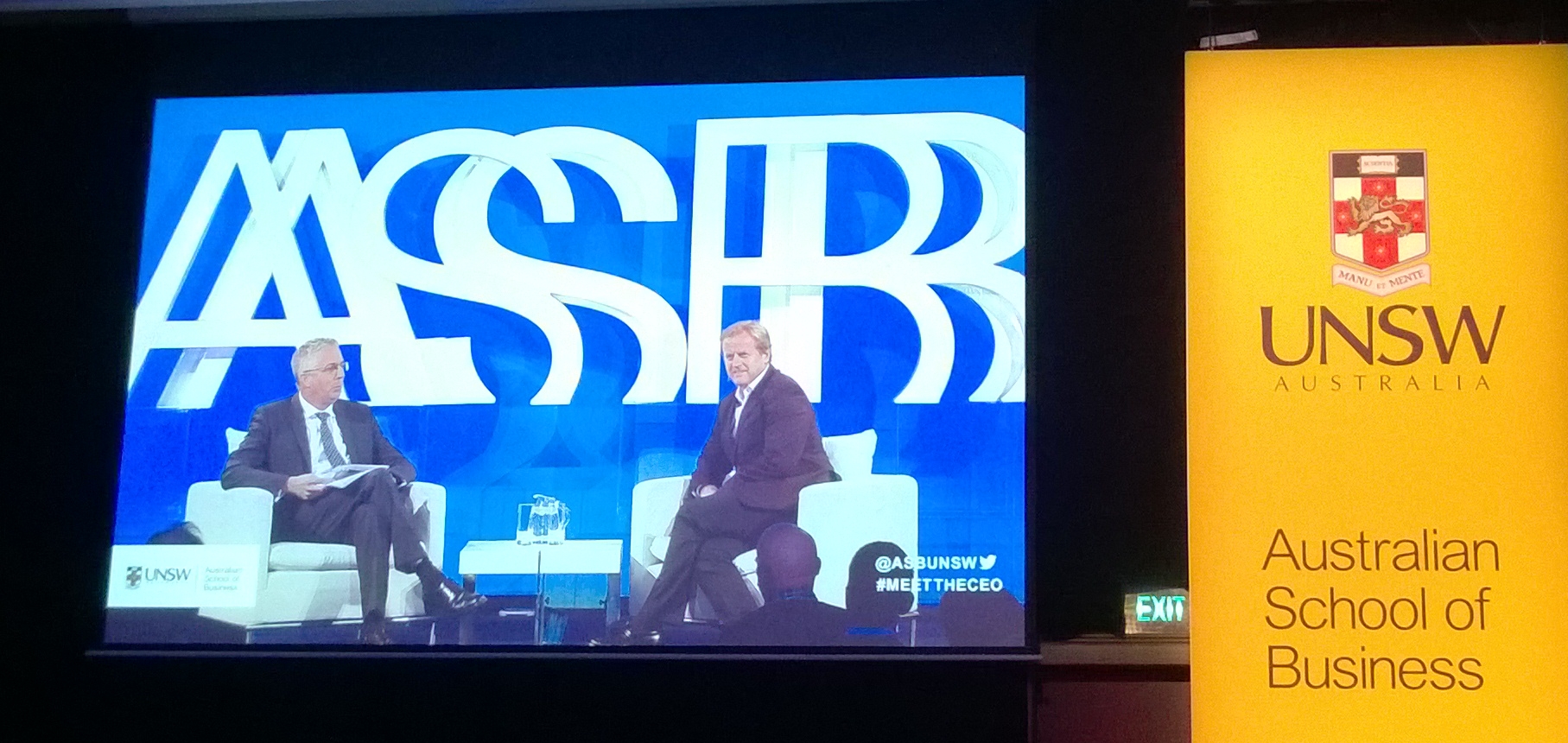
After being introduced by ASB Dean Professor Geoffrey Garrett and NRL Commissioner and ASB Business Advisory Council member Cathy Harris, Mark Scott (Managing Director, Australian Broadcasting Corporation) got down to interviewing David.
I have to admit that I was (pleasantly) surprised by David’s style. I’m a strong believer in using sporting teams rather than military teams as the basis to study business leadership, management and strategy. I went in thinking that David would use lots of sporting language in his interview. Instead, we were presented with an articulate, sophisticated banker who talked about managing an iconic Australian sporting organisation in an intensely competitive and challenging environment.
At one point in the interview he explained that this was a business audience and the conversation was about the business of sport, so he felt it was the appropriate language to use. He talked a lot about market positioning, local and international growth strategies and leveraging brand equity. It was all very insightful, however I felt at a couple of points that his responses were more rehearsed and media-trained than spontaneous. Nevertheless, he was still very polished and impressive.
I won’t summarise the interview, but here are some of my take-aways from his answers.
Need for strong business discipline
No matter what sort of organisation, at some point it will need to be managed professionally if it is to be sustainable and grow. The NRL is a perfect example. Even with strong cultural and community roots and passionate (fanatical) supporters, when David took over it was in pretty bad shape for an organisation of its size and age. The NRL Commission and David have implemented rigorous business thinking and strategies, and the results are evident in both on-field and off-field performance of the League.
Ability to abstract and apply transferable skills
At first, the choice of an investment banker to run a national sporting organisation seems strange. But as both Cathy and David pointed out, one of the reasons he’s able to do well is the ability to apply transferable skills that he brings from his previous roles. David mentioned that this was his fourth “career”, including an engineering background, military service and banking.
In addition to the ability to abstract problems and apply skills learned in seeming unrelated fields, I also think that introducing someone from outside an industry vertical provides an opportunity to approach issues from a fresh perspective. In my own career, I’ve found that this has helped me challenge embedded assumptions and re-frame conversations.
Stay connected to your origins
When asked how he is able to relate to the everyday person and the NRL fans, David talked about staying connected to his origins. He talked about coming from a mining town with modest means, and not forgetting that.
This reminded me a bit of Cameron Clyne, the CEO and Managing Director of the National Australia Bank. In his Meet the CEO interview, he talked about growing up in a mining family and using the strong work ethic instilled in him to stay grounded.
Speak the appropriate language
The other advice he gave was to speak in a language that was appropriate to your audience. The obvious example was his use of sophisticated business terminology suited to the audience at the event. However, he said that when talking to the clubs and their members, he uses terms and ideas that make sense to them.
Seems a bit obvious, but a good reminder nevertheless. This is especially important for technology professionals, who need to get better in speaking in terms of business problems and solutions rather than IT implementations.
It was a great event, and the AGSM did a great job hosting it. (The arancini balls at reception were awesome!)
If you’re interested, the recorded video of the interview is well worth watching:
Jun 12, 2014 | Events, Leadership, Management, People Management |
As always, I continue to be amazed by my kids’ abilities to teach me lessons by forcing me to think about behaviours – theirs, mine, and people’s in general.
A lesson in the wild
This one came about during a recent camping trip. Hamzah and I camped overnight at the beautiful Bents Basin Campground, where we spent the day walking around trails and exploring the area. The next morning as I was preparing breakfast, Hamzah asked if he could have an Up&Go first. As I gave it to him, I asked him to sit down and pay extra special attention while he drank it. I told him that if he spilled it over himself we wouldn’t have a spare set of clothes for him to change into.
Now I know that he’s only 5 (or 5 and a half as he likes to correct me) and doesn’t really have the ability to sit quietly and drink out of a straw from a milk pack while actually wanting to run around with his friends, but hey, I can try, right?
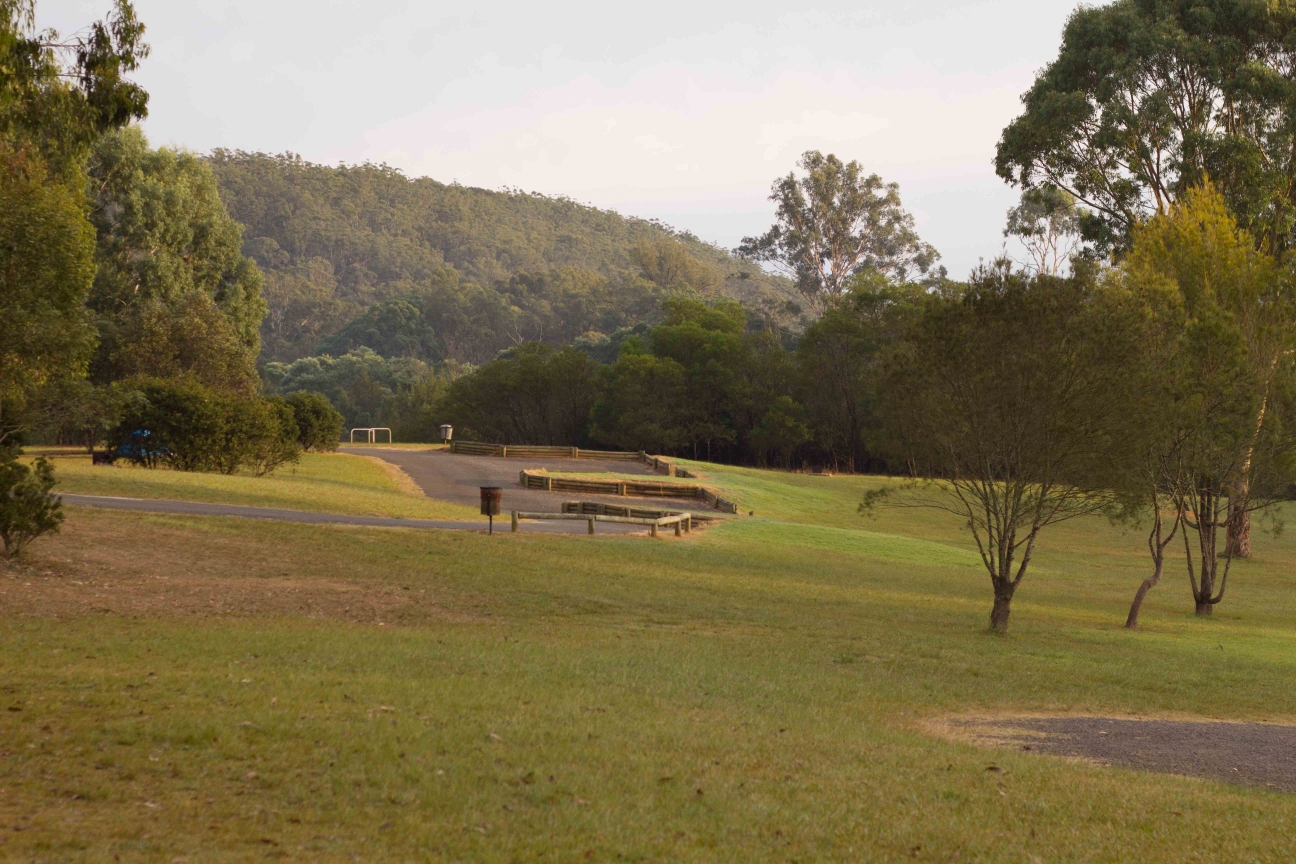
As I finished cooking the eggs and toast, I went over to check how he was doing and found him sitting very quietly. When I squatted down, his eyes were full of tears and he said “send me to the naughty corner Baba”.
At first I didn’t understand. But when he repeated that he should be sent for a time-out as punishment, I noticed that he had (almost predictably) spilt a little milk on himself. As I smiled, gave him a big hug and wiped the tears (and spilt milk) away, it struck me how important it was to him to try to do what he thought was the right thing.
I hadn’t threatened him with punishment or even pressed the importance of not spilling the milk on him, merely made a passing comment as I had handed him the pack. Yet, he felt his mistake was bad enough to be disciplined, that he had let me down in a major way.
This was interesting. What was the reason for him to not only recognise that he had done something wrong, but to also ask to be sent to the naughty corner? Was it the thought of having disappointed me? Was it the intrinsic recognition that he had made a mistake?
This got me thinking about something I had heard a few days earlier …
An example from the business world
I recently attended an AGSM Alumni event on Customer Centricity, hosted by Dr Linden Brown, author of ‘The Customer Culture Imperative’. Also on the panel were John Parkin – Director of Customer Enablement, Telstra, John Stanhope – Chairman (nonexecutive), Australia Post, Professor Adrian Payne – Professor of Marketing, Australian School of Business, UNSW, and Dr Judith MacCormick, Partner, CEO and Board Practice, Heidrick & Struggles.

It was an excellent session, and is well worth listening to the audio recording as the panel discusses how to build strong, adaptable and innovative customer-centric cultures.
One of the insights from the panel discussion was that customer centricity depends on highly engaged employees. Dr Brown related a story from one of his case studies about Zane’s Cycles, where the store had agreed to put a purchased and decorated bicycle in the store’s display as part of a customer’s Valentine’s Day gift. For some reason, the bicycle wasn’t put on display, resulting in a very upset customer.
The rest of the story about how the business handled the situation is exemplary, and resulted in a happy outcome for both the business and the upset customer. However, one of the incredible parts of the story that stuck with me was the store employee who had been responsible for putting the bicycle in the store display recognised his mistake, and voluntarily wrote out a cheque for $400 to the store as compensation for the incident. To me this was an example of an employee who was so engaged that he volunteered to be (financially) disciplined.
Here is the 3-and-a-bit minute video of Chris Zane – owner of Zane’s Cycles – talking about the event and how it unfolded. Well worth watching.
Creating strong engagement
I had a think about both these situations with Hamzah and the bicycle store employee, and how people get to the point where they are completely engaged. I can’t comment on the culture at Zane’s Cycles since I haven’t experiences it first-hard, but there are plenty of articles and videos on the internet discussing how they operate. I also recognise that Hamzah is only a child, and my child at that, so there is a certain amount of influence that filial piety plays in that situation.
However, I’ve also observed this sort of engagement in my own teams, and here are some of the things that I believe can help create an environment that supports it.
Have clear and genuine values
Everyone, including organisations, have values, whether they explicitly recognise them or not. The important step in creating engagement is to be clear about what these values are, and why they are important to you. In addition to this, you really need to live these values – to lead from the front, so to speak. When people believe in your values and see you living and breathing them, they will usually follow.
Provide people the freedom to make their own mistakes
This is about empowering people and giving them the latitude, respect and encouragement to try whatever path they want to take to get to the goal. Needless to say, this must be within reasonable boundaries and in congruence to the values discussed earlier. I’ve found that if you give people responsibility, trust in their abilities and provide a safe environment to fail, they intrinsically become committed to “going the extra mile”.
Don’t sweat the small stuff
Finally, remember that everyone makes mistakes. I make them all the time. If the mistake is genuine (i.e. not deliberate) and can be recovered from without too much effort, sometimes it’s better just to let it go. People remember this and give you emotional credit for it, and when the time comes around where extra effort is required, they will put it in without being prompted.
Creating a culture that promotes strong engagement is a long-term and complex endeavour based on leadership and insights. What have you found that works for you?
May 6, 2014 | Events, Management |
Note: A
version of this post was published on the CIO Australia website (http://www.cio.com.au) on 16 April 2014.
The AGSM kicked off this year’s Learn@Lunch series on 19 February 2014 with an enticing question:
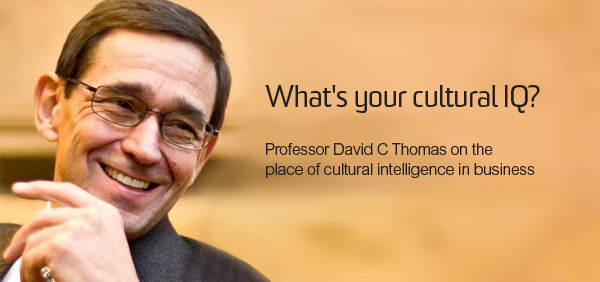
The question was being asked by David C. Thomas, PhD, who is currently Professor of International Business in the School of Management at the Australian School of Business, University of New South Wales. An accomplished academic, he is also the author of eight books, including … wait for it … Cultural Intelligence: Living and Working Globally.
Cultural Intelligence explained
Dr Thomas defines Cultural Intelligence as one’s ability to deal effectively with the cultural aspects of their environment. This important because as we become increasingly globally interconnected, we need to interact more and more frequently with people of other cultures. It is impossible to understand all cultures, and indeed to even comprehend more than a few (except superficially). As Dr Thomas points out, many well rounded, socially and emotionally intelligent people struggle with cross-cultural interaction.
The good news however, is that Cultural Intelligence can be developed using three interrelated elements: Knowledge, Skills and Mindfulness.
Knowledge
This element of Cultural Intelligence is about understanding what culture is. At minimum, it is an abstract understanding of the concept of culture – as in being aware that others may be culturally different to oneself. In practice, it means having working knowledge of the details and nuances of the particular culture one needs to interact with. It also requires the ability to distinguish between personal behaviour and societal norms.
Skills
These are the behavioural meta-skills needed to become more culturally intelligent:
- Perceptual Acuity – sharpness of perceiving details around you
- Empathy – the ability to understand and share the feelings of another
- Tolerance for ambiguity
- Relational Skills – being able to relate to others
- Adaptability
As you become more competent at these, you can select which ones to use in a situation requiring cultural tact.
Mindfulness
Finally, this is the mediating step that links knowledge with skills. It is essentially the opposite of mindlessness, where you are simply unaware of your cultural context. It lets you stop, take account of the situation you’re in, recall the knowledge about your context, and then apply your behavioural meta-skills to behave in a culturally appropriate way.
An interesting example: Carlos Ghosn – A (culturally) smart cookie
One of the more fascinating examples of someone with high Cultural Intelligence Dr Thomas gave was Carlos Ghosn, the President and Chief Executive Officer of Nissan Motor Co., Ltd. Ghosn is a French-Lebanese-Brazilian who is largely credited with one of the most dramatic downsizing and turnarounds of a major organisation in the modern business era. What’s even more fascinating is that he runs this massive multi-national by splitting his time evenly between Tokyo and Paris, both places steeped in distinct, rich cultures and business customs.
Ghosn’s management style is frequently described as cross-cultural, and he credits his ability to navigate between cultures as one of his strengths. In his CEO message on the Nissan Global website he points out that cultural diversity can create a competitive advantage, saying that “solutions come from using the talents of both men and women, young and old, from all levels in the organization or from different cultures.”
He even has his own superhero comic book series. That’s right – “The True Life of Carlos Ghosn”. (I’m trying to imagine a comic book based on my life. Probably wouldn’t be as exciting.)
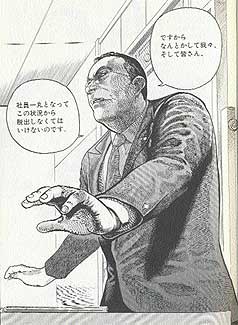
Experiencing different cultures
The lecture really resonated with me since I have worked in a number of situations that have required interacting with people with different cultural backgrounds, and reflecting on those situations makes me realise how important cultural intelligence really is.
Local interactions
One of the things I love about living in Sydney is the exposure and ability to interact with a plethora of cultural backgrounds. I’ve been privileged to work in a number of organisations where many of my colleagues had different ethnic backgrounds and upbringings. This also provides some interesting challenges.
For example, I once worked with a number of Japanese colleagues for a couple of years. It was my first time interacting closely with people of Japanese background, and I remember getting very frustrated. We would spend lots of time in deep and intense discussions, which would mostly end in what I thought was an agreement. Later, I would find out that they would renege on that agreement or deny having reached it at all.
After a few of these events, it occurred to me that the reason for this misunderstanding was largely cultural: when they nodded during our discussions, they were just being polite and letting me have my say. Whereas I had taken their nods to mean acceptance, they were simply nodding in acknowledgement of having heard my point of view.
Once I realised this, I had to change my approach to incorporate this cultural understanding. I re-framed the conversations to try to get their points of view out without trying to push mine first, and making sure at any agreement we reached as actually explicitly acknowledged as such.
Remote interactions
Working for a global companies is also an interesting exercise in cultural awareness, where many of your colleagues are from and located in different parts of the world. Not only are they from a different culture, they are in a different culture and of course behave within its norms.
Being culturally intelligent can be very helpful here, not only to foster strong relationships across the organisation, but also to be effective in your job if it requires frequent cross-regional interactions.
For example, when rolling out changes to business processes or technology systems, it can really help to be aware of how different cultures react. I’ve found that changes are better implemented via mandate in certain parts of the world, while others require more of a co-opting approach.
Organisations as Cultural Containers
While not quite the idea that Dr Thomas was talking about, each organisation has its own unique culture as well. I’ve worked in a large variety of organisations, from two person to 10,000 strong consulting firms, government departments, financial services institutions and global system integrators while covering a wide range of industries. While industry norms exist, company culture usually varies significantly between organisations of the same size in the same market. Many of the ideas discussed in the lecture can be adapted to a micro-level and used to intelligently navigate the culture within the specific place you work at.
Takeaways
All this made me think about how real this is as an actual, practical concept, not just an academic one. Certainly in Australia, the importance of being able to effectively interact with our neighbouring countries has recently gained much prominence. This is highlighted in publications such as Australia in the Asian Century, which was mentioned by both David Thodey as well as Andrew Stevens, and also discussed by Professor Joseph Cheng.
In the end, however, the best reason to develop your Cultural Intelligence is to be able to more effectively deal with people of other cultural backgrounds. As Stephen Covey said, “seek first to understand, then be understood“.
Oct 28, 2013 | Events |

I had the lunch hour available, so I took the opportunity to get to the AGSM CBD campus and attend the Learn@Lunch session on Thursday, 24 October. The lecture was titled “Competing in the New Innovation-Driven Global Economy: Opportunities and Challenges for Australia and Asia“, and was delivered by Professor Joseph Cheng.
Dr Cheng is a Professor of Management and the Michael J. Crouch Chair in Innovation in the Australian School of Business at UNSW. He recently arrived in Sydney from Chicago, where he was Professor of International Business and Director of The CIC Center for Advanced Study in International Competitiveness at the University of Illinois at Urbana-Champaign.
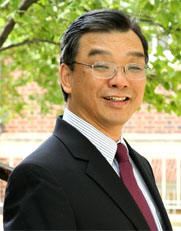
The premise of the talk was a rather interesting observation by the McKinsey Global Institute in their June 2012 report titled “Urban world: Cities and the rise of the consuming class“:
“Until 1500, Asia was the center of gravity of the world economy, accounting for roughly two-thirds of the global GDP. But in the 18th and 19th centuries, urbanization and industrialization vaulted Europe and the United States to prominence. We are now observing a decisive shift in the balance back towards Asia – at a speed and on a scale never before witnessed. China’s economic transformation resulting from urbanization is happening at 100 times the scale of the first country in the world to urbanize – the United Kingdom – and at ten times the speed.”
Given this scenario, what are the opportunities available to Australia to successfully compete and remain relevant in the region?
Dr Cheng pointed out that the way forward was economic growth based on innovation rather than efficiency, and spent some time contrasting the two models and providing numerous examples of each. He also distinguished between the different types of innovations that occur, and how organisations have used them to change their industries and gain competitive advantages.
He talked about the competitive advantages available to Australia – such as its strategic geographic location between the growing Asian powerhouses on one side and the emerging economies in the Americas on the other – as well as it being considered a safe and attractive place to live. He also observed some of the challenges it faced, such as being one of the countries that facilitated the on-going patent battles in its courts system and the generally risk-averse national culture, both of which are seen to stifle innovation.
In this context, he suggested that Australia could create competitive differentiation by becoming a centre of innovation, using its location to entice innovative individuals and organisations to establish themselves here, as well as becoming an innovation broker between the two emerging economic powers on either side.
It was a very insightful presentation indeed, and unfortunately I had to dash off back to work and miss the Q&A session which looked like it was going to be quite … vigourous. The AGSM staff indicated that a recording of the session will be available, so I’ll update this post with some links when I get access to it. The McKinsey report is also worth reading, and is freely available on their site.
Oct 23, 2013 | Events, Leadership |
Interesting fact: In 2003, the first business leader hosted by the AGSM in the inaugural Meet the CEO event was Richard Branson.
It was somewhat poetic, therefore, that almost exactly a decade later the last Meet the CEO event of 2013 held on Monday featured John Borghetti, CEO of Virgin Airlines.
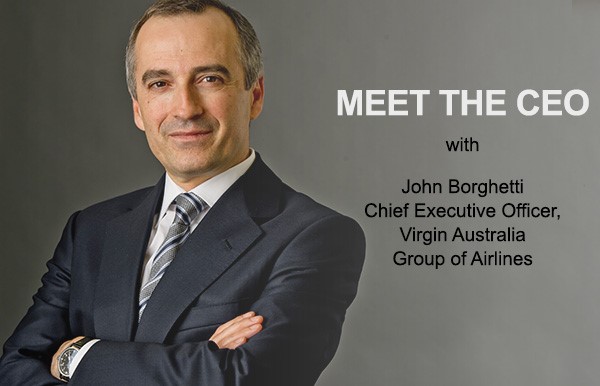
The stage was set from the beginning. There were a number of immaculately groomed Virgin Airlines stewardesses in their distinctive red livery in addition to the AGSM staff welcoming guests to the evening. They even opened the doors to the hall where the interview took place, and ushered us in with effortless smiles and practiced efficiency. I almost wished we had reserved seats so we could have been directed to them.
Dean of the Australian School of Business Professor Geoffrey Garrett was engaging and humourous as always in his introductions. UNSW Chancellor David Gonski in his welcome was even funnier and had the packed hall laughing out loud. The twist – instead of Dr Garrett chatting to the guest as usual, there was also a guest interviewer. Mark Scott, Managing Director of the Australian Broadcasting Corporation stepped onto the stage and masterfully conducted the interview.
John discussed the history and challenges faced by the aviation industry in general and specifically in Australia. He also touched on the opportunities and challenges faced by Virgin as part of competing against Qantas and the brand repositioning strategy he implemented after joining Virgin in 2010.
You can watch the video recording of the interview to catch the whole thing, but here are my observations and insights about John’s leadership style from listening to him tell his stories.
Don’t be afraid to be yourself.
A lot of John’s personality showed through his answers. I’m sure he’s had loads of media training as most people at his level do, but his answers were somewhat less reserved and guarded than the other CEOs I’ve seen interviewed.
For example, he quite happily pointed out that the decline in the Australian resources boom was great, because it meant that mining organisations were now looking for cost efficiencies and open to renegotiating corporate contracts. He then realised that it may have sounded like he was happy about the resource decline in general, and sheepishly clarified that he meant it was great for Virgin Airlines, not necessarily for Australia as a country.
Share your success. There’s plenty to go around.
He talked about and shifted credit away from himself and senior management to front-line staff. Basic leadership recipe, but well executed by publicly acknowledging the importance and achievement of everyone in the organisation.
If you’re in a service industry – like airlines – focus on getting the right people on board (no pun intended).
John pointed out that when you’re flying, you’re basically in a “tube”. The tube is essentially the same regardless of the airline you choose, so the key differentiator is the people who deliver the customer experience.
When asked to elaborate, he said it came down to recruiting well. You have to create and maintain a service culture, and find and attract people with the right customer service attitude and focus. This meant going outside the airline industry to find individuals who were “service people” – whose attitude is based on wanting to please people.
It’s also important to then let those people be themselves, and not beat that attitude out of them.
“Screw it, let’s do it.”
Advice from Richard Branson when faced with rebranding Virgin Airlines Australia differently from the rest of the global Virgin brand. Enough said.
Listen to your front-line staff.
John said that it was impossible for a CEO to “go undercover” and pretend to be a customer. Everyone recognises you and treats you differently – like the CEO. Even if they didn’t, at best you might pick up on some of the challenges faced by front-line staff on the day, and those might not be the most difficult ones they normally face. Rather, spend time talking to them at every opportunity you get, take that feedback on board, and act on it.
Process your email backlog at 3am on Sundays.
Ummm … I might pass on this one for now.
Learn to read people.
John started working in his father’s coffee shop aged 10, and was challenged by him to up-sell to potential customers. It was here that he learnt salesmanship and reading people. He pointed out that this is important because it enables you to understand where they are coming from (empathise with them), which in turn gives you the ability to decide what to do (how to fulfil their needs).
Have a good process to solve problems.
You can’t anticipate all the problems that could potentially arise in an endeavour. However, you know that they will come up, so have a good process to deal with them as they do. Each problem might be different, but having an approach to solving them will go a long way to successfully resolve them.
Work hard and focus on doing a great job.
When asked what advice he had for someone starting off in the airline industry, John responded with the advice he gave his own daughter, not specific to airlines, but for careers in general:
Work hard. Focus on your current job and do it well. You will see other people around you get ahead without working hard. Don’t worry about them. They’ll come crashing down eventually.
Really good advice, and something I’ve personally observed.
Thanks AGSM. Really enjoyed the conversation, and am looking forward to meeting more CEOs next year.








